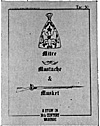 This was written by Ben King and published by
Systems Analysis. This is one of their series of Tac-50
miniature rules. They have a pike and shot set, 18th
century, Napoleonics, and a 19th century. All are the
same figure ratio, 1:50. They use about the same rules in
each set and to learn one is almost like learning all of
them. The individual periods have their own unique rules,
though. The ground scale is one inch equals 25 yards.
This was written by Ben King and published by
Systems Analysis. This is one of their series of Tac-50
miniature rules. They have a pike and shot set, 18th
century, Napoleonics, and a 19th century. All are the
same figure ratio, 1:50. They use about the same rules in
each set and to learn one is almost like learning all of
them. The individual periods have their own unique rules,
though. The ground scale is one inch equals 25 yards.
One turn equals approximately 20 minutes of real time. One needs two normal six-sided dice to play. Base sizes are determined by the number of figures in a company. The frontage per figure depends on the troop type- line infantry is 5/8", light infantry, artillery crewmen and cavalry have a frontage of 7/8~ per figure. Unlimbered artillery has a front of 3".
Prior to the game a battle plan must be devised. Each unit must be given battle orders. No additional orders need be written during the game unless changes of formation are involved.
The rules cover terrain and weather effects. There is an illustration of formations and definitions. Organization of the major powers is given, including the North American conflict. A simple sequence of play is also presented.
Melee is simple but deadly. Each troop type has a melee value. The value of each unit's troops is totalled. Two dice are thrown and their difference is cross referenced with the total melee value of the unit. This gives the number of melee points lost by the opposition. Enough figures are removed to satisfy the melee point loss. The dice difference is determined by subtracting the larger die value from the smaller, always resulting in a positive value. A zero result is rerolled.
Melee occurs between total units regardless of relative positions, except those melees involving squares. Only troops in whole or partial contact can melee a square. Troops which are prone can suffer fewer casualties from cavalry in melee (except against lancers).
Fire casualties are determined similar to melee, except the number of figures firing is used rather than the number of melee points. The first turn of fire allows line infantry and grenadiers to fire two volleys. When two units are eligible to fire at the same time, each side throws two dice and the higher score fires first. Ties fire simultaneously.
Artillery fire is simple also. When firing shell or ball the player must select his target and estimate the range to the target. If the target is within 6" of the estimated range a ball hit is scored. If within 3", a shell hit is scored. An estimated range which falls short is a miss. If a hit is scored then the casualty table is consulted to determine the number of figures removed. Cannister needs no range extimation. It automatically hits the target and casualties are determined from the casualty table. Counterbattery fire demands an estimated range within 1", and a dice difference of 4 or 5. Three hits silence a gun model. One die is thrown and a 'one' indicates an artillerist figure is lost.
Though simple as well, morale is the most complicated part of the rules. Two dice are thrown using the values 2 through 12. Modifiers are made according to losses and the tactical situation. Then the result is compared to the morale class of the unit. There are only three morale classes - militia and landwehr, line infantry and grenadiers, cavalry and light infantry. Morale results are carry on, retreat, and rout.
Included with the rules are two reference cards which cover the major points of the rules. These rules are the simplest and fastest of the group. They suffer from not having a true point value system, although the melee point system will work. Casualties can be deadly but it still makes a fun game.
The Rules
-
7YW Rules Introduction
7YW Rules Tricorne
7YW Rules Wargame Rules 1685-1845
7YW Rules Mitre, Mustache, and Musket
7YW Rules Frederick the Great
7YW Rules Ken Bunger Comments
Back to Table of Contents -- Courier Vol. 2 #3
To Courier List of Issues
To MagWeb Master Magazine List
© Copyright 1980 by The Courier Publishing Company.
This article appears in MagWeb (Magazine Web) on the Internet World Wide Web.
Other military history articles and gaming articles are available at http://www.magweb.com